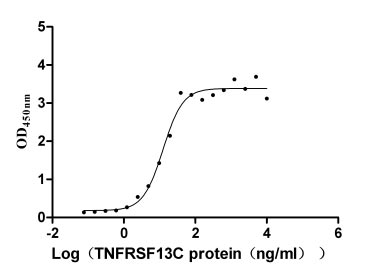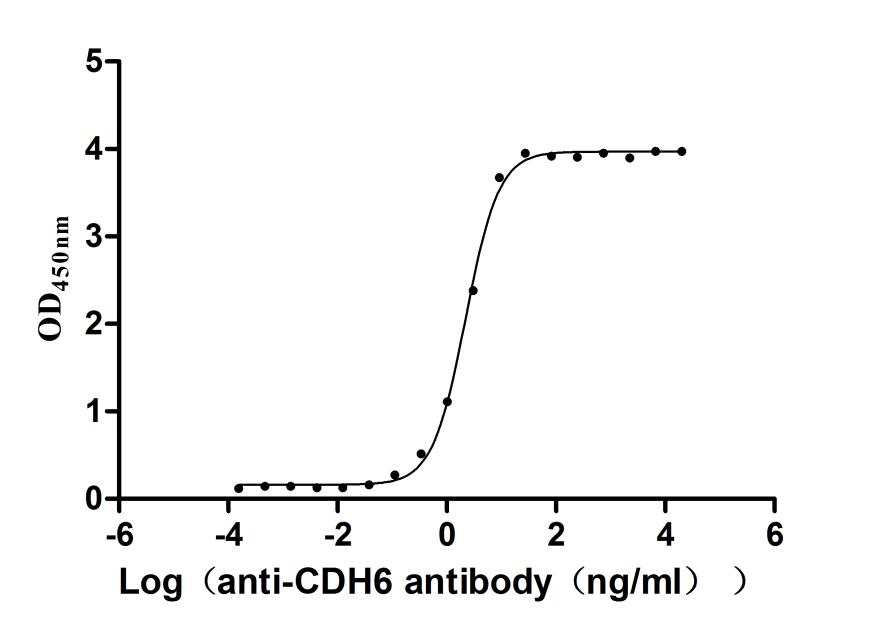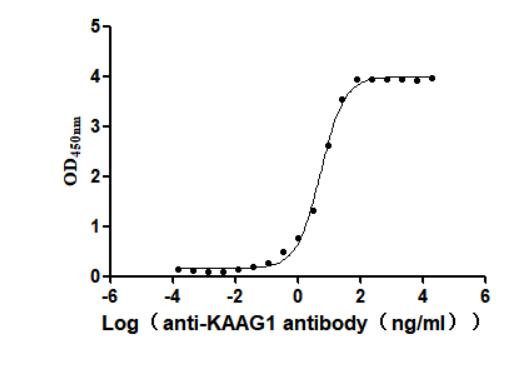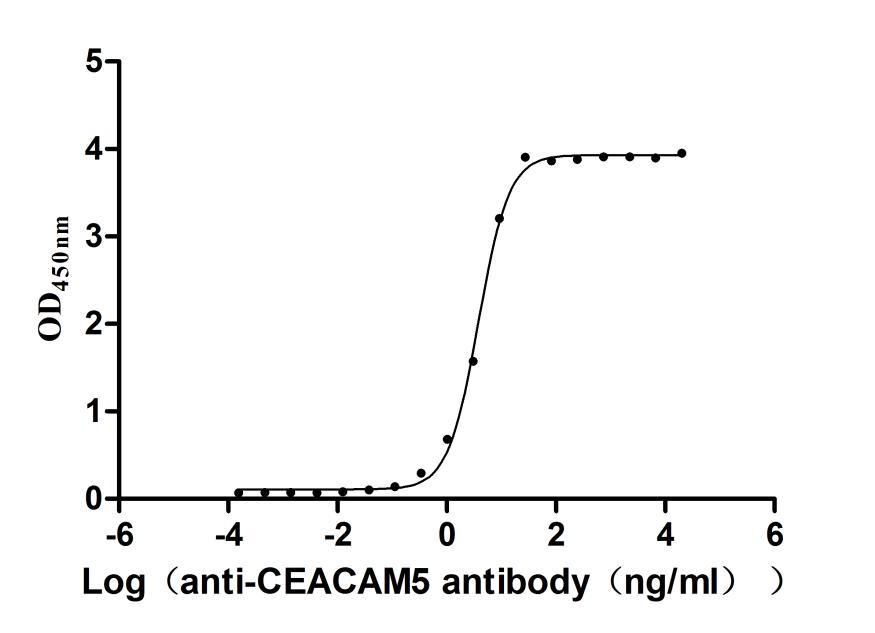Recombinant Mouse Protein-lysine 6-oxidase (Lox)
-
中文名称:小鼠Lox重组蛋白
-
货号:CSB-YP013038MO
-
规格:
-
来源:Yeast
-
其他:
-
中文名称:小鼠Lox重组蛋白
-
货号:CSB-EP013038MO
-
规格:
-
来源:E.coli
-
其他:
-
中文名称:小鼠Lox重组蛋白
-
货号:CSB-EP013038MO-B
-
规格:
-
来源:E.coli
-
共轭:Avi-tag Biotinylated
E. coli biotin ligase (BirA) is highly specific in covalently attaching biotin to the 15 amino acid AviTag peptide. This recombinant protein was biotinylated in vivo by AviTag-BirA technology, which method is BriA catalyzes amide linkage between the biotin and the specific lysine of the AviTag.
-
其他:
-
中文名称:小鼠Lox重组蛋白
-
货号:CSB-MP013038MO
-
规格:
-
来源:Mammalian cell
-
其他:
产品详情
-
纯度:>85% (SDS-PAGE)
-
基因名:
-
Uniprot No.:
-
别名:Lox; Rrg; Protein-lysine 6-oxidase; EC 1.4.3.13; Lysyl oxidase; Ras excision protein) [Cleaved into: Protein-lysine 6-oxidase; long form; Protein-lysine 6-oxidase; short form]
-
种属:Mus musculus (Mouse)
-
蛋白长度:Full Length of Mature Protein
-
表达区域:163-411aa
-
氨基酸序列DDPYNPYKYSDDNPYYNYYDTYERPRPGSRNRPGYGTGYFQYGLPDLVPDPYYIQASTYVQKMSMYNLRCAAEENCLASSAYRADVRDYDHRVLLRFPQRVKNQGTSDFLPSRPRYSWEWHSCHQHYHSMDEFSHYDLLDANTQRRVAEGHKASFCLEDTSCDYGYHRRFACTAHTQGLSPGCYDTYAADIDCQWIDITDVQPGNYILKVSVNPSYLVPESDYTNNVVRCDIRYTGHHAYASGCTISPY
-
蛋白标签:Tag type will be determined during the manufacturing process.
The tag type will be determined during production process. If you have specified tag type, please tell us and we will develop the specified tag preferentially. -
产品提供形式:Lyophilized powder
Note: We will preferentially ship the format that we have in stock, however, if you have any special requirement for the format, please remark your requirement when placing the order, we will prepare according to your demand. -
复溶:We recommend that this vial be briefly centrifuged prior to opening to bring the contents to the bottom. Please reconstitute protein in deionized sterile water to a concentration of 0.1-1.0 mg/mL.We recommend to add 5-50% of glycerol (final concentration) and aliquot for long-term storage at -20℃/-80℃. Our default final concentration of glycerol is 50%. Customers could use it as reference.
-
储存条件:Store at -20°C/-80°C upon receipt, aliquoting is necessary for mutiple use. Avoid repeated freeze-thaw cycles.
-
保质期:The shelf life is related to many factors, storage state, buffer ingredients, storage temperature and the stability of the protein itself.
Generally, the shelf life of liquid form is 6 months at -20°C/-80°C. The shelf life of lyophilized form is 12 months at -20°C/-80°C. -
货期:Delivery time may differ from different purchasing way or location, please kindly consult your local distributors for specific delivery time.Note: All of our proteins are default shipped with normal blue ice packs, if you request to ship with dry ice, please communicate with us in advance and extra fees will be charged.
-
注意事项:Repeated freezing and thawing is not recommended. Store working aliquots at 4°C for up to one week.
-
Datasheet :Please contact us to get it.
相关产品
靶点详情
-
功能:Responsible for the post-translational oxidative deamination of peptidyl lysine residues in precursors to fibrous collagen and elastin. Regulator of Ras expression. May play a role in tumor suppression. Plays a role in the aortic wall architecture.
-
基因功能参考文献:
- LOX over-expression in vascular smooth muscle cells was associated with a change in the structure of collagen and elastin fibres; LOX could constitute a novel source of oxidative stress that might participate in elastin changes and contribute to vascular remodelling PMID: 28624291
- LOX up-regulation is associated with enhanced oxidative stress that promotes p38MAPK activation, elastin structural alterations, and vascular stiffness. PMID: 28010122
- These results suggest that LOX has the ability to induce RANKL expression on stromal cells; however, it fails to substitute for RANKL in osteoclastogenesis. PMID: 27606829
- UXT Is a LOX-PP Interacting Protein That Modulates Estrogen Receptor Alpha Activity in Breast Cancer Cells. PMID: 28106301
- Data show that LOX-PP enhances adipogenesis at least partially through inhibition of FGF-2 receptor signaling. PMID: 28452589
- LOX targeting reduces peritoneal fibrosis. PMID: 28800626
- Absence of lysyl oxidase (Lox) causes thoracic aortic aneurysms. The aortic mechanical behavior of Lox(-/-) mice is consistent with reduced elastin and collagen cross-linking but demonstrates vascular location-specific differences. Lox(-/-) aortas show upregulation of matrix remodeling genes and location-specific differential expression of other matrix and smooth muscle cell gene sets. PMID: 28550176
- Findings from this study indicate that preventing LOX overexpression may be protective against high glucose-induced apoptosis in retinal vascular cells associated with diabetic retinopathy. PMID: 28538980
- LOX family members contribute significantly to the detrimental effects of cardiac remodelling, highlighting LOX inhibition as a potential therapeutic strategy for post-infarction recovery PMID: 26260798
- Findings suggest that the lysyl oxidase (LOX)-mediated organization of collagen fibers in the extracellular matrix is an important regulator of osteoblastogenesis. PMID: 26497171
- The data suggest a fibromodulin-modulated collagen cross-linking mechanism where fibromodulin binds to a specific part of the collagen domain and also forms a complex with lysyl oxidase, targeting the enzyme toward specific cross-linking sites. PMID: 26893379
- Data suggest of pharmacologic targeting of lysyl oxidase (LOX) pathway to inhibit liver fibrosis and promote its resolution. PMID: 26700732
- Cu chaperone function of Atox1 mediated through Cu transporter ATP7A is required for VEGF-induced angiogenesis via activation of Cu enzyme lysyl oxidase. PMID: 26437801
- CTR1, ATP7A, and lysyl oxidase were upregulated in the lung tissues and pulmonary arteries of mice with hypoxia-induced pulmonary hypertension and pulmonary arterial smooth muscle cells. PMID: 24614111
- Inhibition of tissue transglutaminase resulted in a reduced rate of compaction compared to controls during early remodeling (up to 2 days). In contrast, inhibition of lysyl oxidase did not alter the early compaction. PMID: 25924936
- decreased expression of cross-linking enzymes (LOXs) and increased expression of ECM-degrading proteinases (MMP-1, 2, 3) might be of great contribution to poor healing ability of PCL ligament PMID: 25416119
- LOX is indispensable for the progression of BLM-induced experimental lung fibrosis by aggravating the inflammatory response and subsequent fibrosis process after lung injury. PMID: 25348956
- LOX and LOXL2 may play an important role in the pathogenesis of AMD. Targeting LOXL2 could have a broader efficacy than targeting LOX, by reducing angiogenesis and inflammation, as well as fibrosis. PMID: 26258612
- LOX plays a critical role in vascular remodelling PMID: 24990180
- LOX is a novel regulator of NFATc1-driven osteoclastogenesis, independent of RANK ligand, which disrupts normal bone homeostasis leading to the formation of focal pre-metastatic lesions PMID: 26017313
- DDR2 binding and activation were disrupted by collagen glycation, pointing to a mechanism for the diminished levels of lysyl oxidase and consequently low lysyl oxidase-derived cross-links in diabetic bone. PMID: 24120383
- miR-29b down-regulates HSP47 and LOX expression. PMID: 24650661
- lysyl oxidase activity participates in primary tumor growth by directly impacting the senescence stability. PMID: 24113189
- Stromally derived lysyl oxidase promotes metastasis of transforming growth factor-beta-deficient mouse mammary carcinomas. PMID: 23856251
- Silencing of lysyl oxidase in BMP4-treated C3H10T1/2 cells induced a mesenchymal-epithelial transition (MET)-like response associated with the repression of mesenchymal markers, induction of epithelial markers and decreased cell migration. PMID: 23395997
- LOX expression is strongly upregulated in Staphylococcus aureus infections in vivo. PMID: 23649089
- Suggest a causal relationship between LOX downregulation and aortic stiffening in obesity. PMID: 23413430
- Stress urinary incontinence following vaginal trauma involves over-expression of LOX and decreased synthesis of extracellular matrix components or increased proteolysis in the urethra. PMID: 22572217
- Data show that lysyl oxidase LOX staining intensity was intermittent in the ligamentum flavum over from stages E15 to 2 years, and stages that stained intensely were E16 and E18, and P7 through P21. PMID: 22685574
- the lysyl oxidase (Lox) protein is degraded through lysosome and accumulated in the Vps18 deficient cerebellum but not in cerebral cortices. PMID: 22699122
- Lysyl oxidase activity is essential to generate optimal chemotactic sensitivity of cells to chemoattractants by oxidizing specific cell surface proteins, such as platetlet-derived growth factor receptor (PDGFR)-beta. PMID: 21509606
- These results indicate that proLOX could be processed by two different mechanisms producing two forms of active LOX. PMID: 21591931
- LOX-PP is shown to negatively regulate pro-oncogenic beta-catenin signaling in lung cancer cells. PMID: 21690299
- LOX is a potential mediator that couples mechanotransduction to oncogenic signaling by TGF-beta1 and measures capable of inactivating LOX function may prove effective in diminishing breast cancer progression stimulated by TGF-beta1. PMID: 21532881
- in vitro and in vivo data support a novel role for LOX in regulating MK expansion by PDGF-BB and suggest LOX as a new potential therapeutic target for myelofibrosis PMID: 21665949
- Data show that CA9, GLUT1 and LOX mRNA levels were equally and strongly correlated to hypoxic extent in FaDudd, and the same profile was observed for CA9 and GLUT1, but not LOX, in SCCVII tumors. PMID: 21306648
- LKB1 loss of function promotes lung cancer malignancy through remodeling of extracellular matrix microenvironment, and identify LOX as a potential target for disease treatment in lung cancer patients. PMID: 20956321
- Suggest that uric acid increases fibronectin synthesis both in vivo and in vitro via urate transporters through upregulation of lysyl oxidase expression. PMID: 20484295
- periostin supported BMP-1-mediated proteolytic activation of LOX on the extracellular matrix, which promoted collagen cross-linking. PMID: 20181949
- LOX has a novel function in resolving inflammation by reducing MCP-1 in abdominal aortic aneurysm PMID: 19683237
- Lysyl oxidase has a role in oxidizing basic fibroblast growth factor and inactivating its mitogenic potential PMID: 12461785
- lysyl oxidase appears critical during embryogenesis for structural stability of the aorta and diaphragm and connective tissue development PMID: 12473682
- Lox expression is prominent during embryonic cardiovascular development. PMID: 12524683
- Anti-oncogenic effects of lysyl oxidase on ras-mediated transformation are due to its ability to inhibit signaling pathways that lead to activation of NF-kappa B PMID: 12640111
- FGF-2 autocrine pathway inhibits lysyl oxidase transcription in the tumorigenic-transformed RS485 cell line. PMID: 12788924
- The LOX expressed in the choroid plexus, blood vessel walls, brain matrix, and neurons of normal mice. And LOX gene expression was enhanced in the neurons of the spinal cord, brain stem, cortex, caudoputamen and cerebellum in mSOD1 mice. PMID: 14741400
- collagen deposition and lysyl oxidase are regulated by tumor necrosis factor-alpha in osteoblasts PMID: 15138266
- lysyl oxidase functions to inhibit ras-dependent cell transformation PMID: 15277520
- Results compare the immunohistochemical localization of lysyl oxidase and lysyl oxidase-like in various tissues from normal, young adult mice. PMID: 15609098
- the FN matrix may provide specific microenvironments to regulate LOX catalytic activity PMID: 15843371
显示更多
收起更多
-
亚细胞定位:Secreted. Secreted, extracellular space.
-
蛋白家族:Lysyl oxidase family
-
组织特异性:Expressed in aorta (at protein level). Expressed in embryonic, juvenil and adult aorta.
-
数据库链接:
KEGG: mmu:16948
STRING: 10090.ENSMUSP00000025409
UniGene: Mm.172
Most popular with customers
-
Express system: Mammalian cell
Species: Homo sapiens (Human)
-
Recombinant Human Somatostatin receptor type 2 (SSTR2)-VLPs (Active)
Express system: Mammalian cell
Species: Homo sapiens (Human)
-
Recombinant Human Claudin-4 (CLDN4)-VLPs (Active)
Express system: Mammalian cell
Species: Homo sapiens (Human)
-
Recombinant Human CD81 antigen (CD81), partial (Active)
Express system: Mammalian cell
Species: Homo sapiens (Human)
-
Recombinant Human Interleukin-2 (IL2) (Active)
Express system: Mammalian cell
Species: Homo sapiens (Human)
-
Recombinant Macaca fascicularis Cadherin 6(CDH6),partial (Active)
Express system: Mammalian cell
Species: Macaca fascicularis (Crab-eating macaque) (Cynomolgus monkey)
-
Recombinant Human Kidney-associated antigen 1(KAAG1) (Active)
Express system: Baculovirus
Species: Homo sapiens (Human)
-
Express system: Mammalian cell
Species: Macaca mulatta (Rhesus macaque)




















